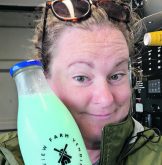The Western Development Museum might not be as old as The Western Producer, but it’s getting up there.
While the Producer was documenting the progress made in prairie agriculture, the Saskatchewan museum was doing the same but with physical objects.
Here is a quick look at how this provincial icon developed over more than 70 years, courtesy of the WDM. For more information about the museum and the history of prairie agriculture, visit www.wdm.ca.
1940: Interested people, working through the Canadian North West Historical Society in the Battlefords, begin to preserve early farm machinery.
1946: Joe Phelps, the provincial minister of natural resources and industrial development, provides $10,000 for an agricultural museum to the group in the Battlefords.
1947: Phelps obtains a hangar at the North Battleford airport to store and exhibit the collected farm machinery.
1949: The WDM opens another collection of farm machinery to the public at a hangar at the Saskatoon airport.
April 2, 1949: The Saskatchewan legislature passes an act creating the Western Development Museum.
April 21, 1949: The WDM board of directors holds its first meeting. The directors are chair Joe Phelps, E.R. Potter, Grant MacEwan, Evan Hardy and Frank Swon.
1951: The Yorkton WDM opens in a hangar at the Yorkton airport.
1952: The Saskatoon WDM moves to a new site on 11th Street West into a hangar moved from Swift Current. A Threshermen’s Reunion is staged as part of the City of Saskatoon’s 70th anniversary.
1954: In October the Saskatoon WDM holds an Old Time Threshermen’s Reunion. This is the beginning of the WDM’s tradition of shows and demonstrations. The Saskatoon WDM’s Threshermen’s Reunion is dubbed Pion-Era.
1956: A three-day Threshermen’s Reunion is held in October at the North Battleford WDM. The board agrees to make a start on a Pioneer Village in North Battleford. The Saskatchewan Tourism advisory council cites the three WDMs as a No. 1 tourist drawing card in the province.
1957: Airplane hangars in Weyburn and Swift Current are secured for artifact storage.
1958: Hist-O-Rama is staged in Yorkton to celebrate the 75th anniversary of Yorkton. CBC chooses Pion-Era in Saskatoon for its historic broadcast in opening its new coast-to-coast microwave system. Prime Minister John Diefenbaker makes an address as part of the event.
1959: Queen Elizabeth and Prince Philip visit the Saskatoon WDM on July 22.
1960: The Pioneer Threshermen’s Club in Saskatoon holds its first steam class.
1961: The hangar at the North Battleford airport is dismantled, moved and erected on the new museum site in North Battleford.
1963: The North Battleford WDM moves to a new site at the junction of highways 5 (now 16) and 40 into a hangar moved from Mossbank. The official opening is May, 25, 1963, as part of North Battleford’s jubilee celebrations. The outdoor village at North Battleford progresses.
1964: The City of Yorkton makes provision for a new WDM site.
1967: The ethnic theme is adopted for the Yorkton WDM. The pioneer village theme is adopted for North Battleford.
1967: WDM shows leadership in the establishment of the Saskatchewan Museums Association.
1972: The Saskatoon WDM moves to a new site on Lorne Avenue South. The new facility features a 1910 vintage prairie village located indoors to permit all-season viewing. The Yorkton WDM moves to a new site on Highway 16 West.
1973: The WDM joins the Canadian Heritage Information Network for artifact collection management.
1974: In June, the sod is turned for a $1.5 million museum to be built in Moose Jaw.
1975: The first WDM course in wheelwrighting is offered, held at the old shop on the 11th Street site in Saskatoon. The first Grade 4 Threshing Demonstration is held at the Saskatoon WDM in response to Saskatoon teachers who wanted a harvest demonstration to support their Grade 4 social studies curriculum.

June 26, 1976: New museum opens in Moose Jaw.
1977: The WDM reorganizes, creating curatorial staff in Saskatoon to serve all four locations.
1982: The WDM stages a nationally acclaimed event, Colony Trek, a wagon trek from Moose Jaw to Saskatoon to commemorate the 100th anniversary of the Temperance colonists’ trek from the end of the rails to their new townsite.
1988: The first WDM blacksmithing course is held at the head office in Saskatoon. The WDM hires its first professionally trained conservator.
1989: The four museum locations are recognized by theme and are named: Moose Jaw — History of Transportation; North Battleford — Heritage Farm and Village; Saskatoon —1910 Boomtown; Yorkton — Story of People. The Saskatoon WDM initiates Harvestfest, a September threshing event.
1996: The WDM launches its first website.
1999: The first class in buggy seat reconstruction and upholstery is held at the Curatorial Centre.
2009: The Winning the Prairie Gamble: The Saskatchewan Story exhibit opens at all four locations.
April 2015: The WDM welcomes its 10 millionth visitor to the museum since opening in 1949.
2017: The WDM launches the Saskatchewan LGBTQ2+ History Collection with the goal of creating a permanent collection of objects that tell stories about LGBTQ2+ life in Saskatchewan.
2018: The bell from the Vulcan locomotive is stolen from WDM Moose Jaw.
2019: WDM releases its Inclusivity Report: Reconciliation and Diversity at the WDM.
2019: The bell from the Vulcan is returned to WDM Moose Jaw.
2019: WDM Saskatoon becomes home to an electric vehicle charging station for public use.
2020: The WDM’s Language Remediation Project begins Answering Calls to Action No. 43 and No. 67 from the Truth and Reconciliation Commission.
Oct. 11, 2022: Together with co-curator Whitecap Dakota First Nation, the WDM opens Wapaha Sk̄a Oyate: Living Our Culture, Sharing Our Community at Pion-Era, 1955-69, a new permanent exhibit at WDM Saskatoon.

















